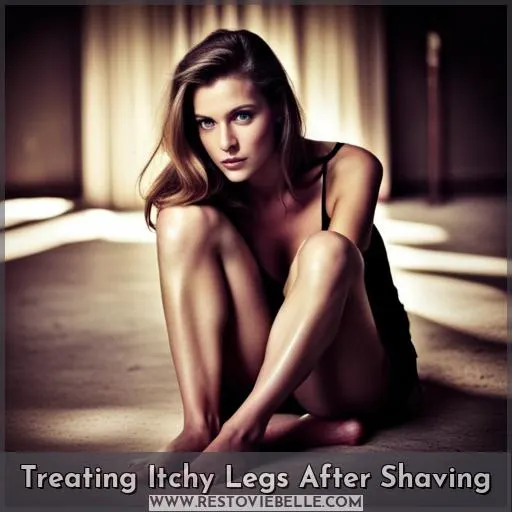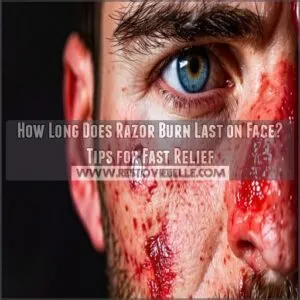This site is supported by our readers. We may earn a commission, at no cost to you, if you purchase through links.
 Are you suffering from itching after shaving? You’re not alone. This kind of skin irritation is common, especially when using a dull razor or shaving sensitive skin. In this article, we’ll explain why you may be experiencing it and offer tips on how to stop the itch in its tracks.
Are you suffering from itching after shaving? You’re not alone. This kind of skin irritation is common, especially when using a dull razor or shaving sensitive skin. In this article, we’ll explain why you may be experiencing it and offer tips on how to stop the itch in its tracks.
Table Of Contents
- Key Takeaways
- Razor Burn and Bumps
- Folliculitis
- How to Avoid Itching After Shaving
- Treating Itchy Legs After Shaving
- Preventing Itchy Pubic Hair
- How to Stop Itching Pubic Hair
- Dealing With Itchy Pubic Hair During the Growing Back Phase
- Tips to Prevent Itchy Pubic Hair
- Best Shaving Practices for Itch-Free Pubic Hair
- Conclusion
Key Takeaways
- Use a sharp razor to reduce irritation and itching.
- Shave with the grain to prevent razor burn and bumps.
- Maintain good hygiene and clean razors with hot water and soap to prevent folliculitis.
- Apply natural oils or moisturizers to soothe and moisturize the skin after shaving.
Razor Burn and Bumps
If you want to avoid razor burn and bumps, always make sure that you’re using a sharp blade and keep your skin moisturized – prevention is better than cure! To combat razor burn, use an electric shaver or switch to a single-blade safety razor.
Trim longer hairs before shaving to reduce tugging, which leads to ingrown hairs. Shave with the grain of hair growth instead of against it for smoother results. Use lubricants like pre-shave oil, followed by thick shaving cream or conditioner, so the blades glide over your skin without catching any follicles.
Afterward, rinse with cool water and apply aftershave balm or cooling gel containing aloe vera extract.
A proper skincare routine like this helps prevent itching after shaving the virginia area, ensuring smooth skin every time.
Folliculitis
You may experience folliculitis, marked by red, acne-like spots and itchiness, after shaving. Folliculitis occurs when Staphylococcus aureus bacteria infect the hair follicles. To prevent or manage this condition, it’s important to practice good hygiene habits.
This includes cleaning razors with hot water and soap before use. Also, avoid using unclean razors and shave in the direction of your hair growth rather than against it to reduce skin irritation.
Additionally, try applying hydrocortisone cream or other soothing moisturizers if you already have symptoms of folliculitis. It’s also important to avoid tight clothing, as it can aggravate itching after shaving areas prone to irritation such as your face or pubic area.
If itching persists for more than three days, consult a doctor for proper diagnosis and treatment plan. Mild cases usually clear up on their own, but severe infections require medication prescribed by medical professionals like antibiotics.
How to Avoid Itching After Shaving
To avoid post-shave irritation, follow best practices like trimming hair before shaving and using a sharp razor.
- Pre Shave Preparation: Take a hot shower or soak in warm water for two minutes to open pores. Trim long hairs with scissors before shaving and don’t forget to use plenty of lubricants like gels or creams while shaving sensitive areas.
- Moisturizing Tips: After rinsing off the area, apply moisturizers that contain natural oils such as coconut oil or almond oil as they can help prevent itching after shaving. Make sure not to use alcohol-containing products on your skin, which can cause further dryness and inflammation.
- Ingrown Hair Prevention: Always make sure you shave in the direction of hair growth when stretching the skin tight so that no hairs get caught up under it, causing ingrowns later on down the line! Also, opt for a fresh razor blade every time—blunt blades are more likely to redirect hair follicles than cut them cleanly, leading to itchiness later on from trapped dead cells around newly grown hairs near their root base!
- Post-shave care: Immediately following any session, be sure to rinse thoroughly again, providing extra hydration via cool cloth compresses, followed quickly by the application of white tea bags. The tannic acid content helps reduce inflammation and promote the healing process faster while also adding nourishment back into the recently damaged epidermis layer! Lastly, remember to wear loose clothing only during the recovery period to allow the body to breathe better and minimize fabric friction contact against freshly shaven exposed surfaces.
Treating Itchy Legs After Shaving
Leg razor burn can be uncomfortable, but you don’t have to suffer – there are ways to treat and prevent it. Applying a cool compress or using hydrocortisone cream for relief is recommended.
If your skin is sensitive, opt for gentle shaving creams. Look out for cooling moisturizers with natural ingredients like aloe vera or witch hazel that soothe irritation after hair follicle stimulation from shaving.
Try not to shave dry legs as this will increase the chances of getting redness, bumps, and itchiness due to friction on delicate areas such as the pubic region. Thicker, curlier hairs can lead to ingrowns if not properly trimmed before applying any lather product when going against their growth direction.
Remember to stretch your skin tight at all times during each pass of the blade, which should always be sharp enough to avoid tugging on every single strand, causing more inflammation.
When dealing with itching afterwards, avoid scratching altogether. Instead, try warm compresses applied twice per day until symptoms subside completely. Follow these basic tips designed specifically to reduce any potential discomfort associated with post-shaving activities resulting from improper management of hair growth and pre-shave preparation techniques implemented prior to mentioned grooming sessions.
Preventing Itchy Pubic Hair
Shaving the pubic region can be tricky and cause razor burn, ingrown hairs, and itching. To prevent irritation in this sensitive area, it is important to use the proper technique when shaving with a sharp blade, as well as taking care of your skin before and after you shave.
Razor Burn
Razor burn can be a frustrating experience, leading to redness and itchiness that can last for days. To prevent razor burn, use sharp razors with lubricants like shaving creams or gels. Shave in the direction of hair growth while stretching skin tight and rinse blades frequently.
Moisturize after shaving with fragrance-free lotions to soothe skin irritation from dryness. For an extra layer of protection against ingrown hairs, apply a warm compress before trimming long pubic hair or try natural oils such as coconut oil prior to shave time! Razor burn management requires using clean razors, avoiding excessive friction when shaving sensitive areas like the face and pubic region.
Ingrown Hair
Ingrown hairs, caused when hair curls inward instead of outward and gets trapped in the skin, can lead to itching after shaving. To prevent ingrown hairs from happening, use a sharp razor for a clean shave. Also, be sure to moisturize before and after every shave as this will reduce irritation while also ensuring that the blade glides over your skin without catching any follicles or tugging on them too hard.
When you do end up with an ingrown hair, it’s important to treat it quickly. One way of softening the area is by using warm compresses. This will allow you to gently remove any entrapped hairs with tweezers or a sterile needle if necessary.
Finally, make sure post-shave care includes applying cooling gels like aloe vera and witch hazel. These gels help relieve inflammation while soothing itchiness associated with ingrowns.
How to Stop Itching Pubic Hair
If you’re experiencing itching and discomfort after shaving your pubic hair, there are a few steps you can take to ease the irritation. Applying hydrocortisone cream or using natural oils like coconut or almond oil may help reduce inflammation.
Additionally, applying a cold compress with a clean washcloth for several minutes will soothe the itchiness, while wearing loose clothing helps prevent further friction on the area.
Hydrocortisone Cream
Hydrocortisone cream is a great option for treating itchy pubic hair. Studies show that 70-90% of people experience relief from itchiness after applying the cream. Its moisturizing benefits are ideal for post-shave care and avoiding harsh chemicals, which can lead to razor rash and skin irritation.
Natural Oils
Try treating your itchy pubic hair with natural oils like coconut or almond oil to soothe irritation. Consider olive, tea tree, and jojoba too! All these have skin care benefits that can help reduce redness and inflammation caused by shaving in sensitive areas such as Virginia.
With regular use, you’ll notice smoother skin with fewer razor bumps over time. Natural oils are a great solution to combat post-shave itching while also leaving your most delicate area looking its best!
Cold Compress
To soothe itchy pubic hair after shaving, apply a cold compress to reduce irritation and take the edge off. Itching is a common side effect of shaving due to skin inflammation and follicle sensitivity.
Relieving discomfort with an icy washcloth helps cool down inflamed areas for post-shave comfort. Cold compresses also provide itch relief by relieving redness, reducing swelling, calming any burning sensations, and providing much-needed moisture from razor burn or dryness.
Loose Clothing
Wear loose-fitting clothing to prevent friction and reduce itching of pubic hair. Choose fabric choices that are skin-friendly for post-shave comfort, such as cotton or silk. Clothing style can contribute to irritation after shaving; consider wardrobe considerations while avoiding tight garments.
Aloe vera and witch hazel cooling gels provide relief from itchiness, along with wearing looser clothes when possible after shaving the pubic region for a more comfortable experience overall.
Dealing With Itchy Pubic Hair During the Growing Back Phase
Avoiding discomfort and irritation while your pubic hair grows back can be challenging, as the thicker, curlier hairs are more prone to ingrowns and inflammation. To prevent itching during this period, it’s important to trim long hairs before shaving.
Shower in hot water to open up pores before using a sharp razor with gentle strokes following the direction of hair growth. Using a sensitive skin shaving cream or conditioner will help soften hair further than plain soapy lather alone and reduce tugging at follicles for smoother shaves with less irritation afterwards.
Afterward, apply natural oils like coconut or almond oil that contain no alcohol-based ingredients, which may dry out the skin even more, leading to increased itchiness from razor burn. For relief, cold compresses are effective, but avoid scratching if possible. Instead, use hydrocortisone cream or a topical steroid solution recommended by dermatologists for treating inflammation caused by post-shave rashes, redness, bumps, and uncomfortable sensations when clothing rubs against abrasive areas on tender freshly shaved skin surfaces.
Bodies need time to heal properly, so loose-fitting clothes should be worn to allow air to circulate freely around affected areas, allowing healing to take place according to schedule, free from any type of tight friction-causing irritants.
Tips to Prevent Itchy Pubic Hair
To prevent itchy pubic hair, take precautions before shaving, such as trimming long hairs and using a sharp razor. An ounce of prevention is worth a pound of cure. For best results, thoroughly clean the area with warm water.
Use lubricants like coconut oil or aloe gel to reduce friction. Additionally, choose your razor wisely.
Post-shave care should include moisturizing the skin immediately after shaving with natural oils or creams to soothe irritation. Avoid tight clothing that may cause further itching from fabric friction. Apply cold compresses when needed if you experience any discomfort after.
Best Shaving Practices for Itch-Free Pubic Hair
Following the right shaving practices can keep your pubic hair itch-free. Start by properly trimming long hairs before shaving and use a sharp razor blade – dull blades can cause more irritation and lead to ingrown hairs.
Shave in the direction of your hair growth, while stretching the skin taut with one hand for maximum comfort and reducing tugging on each follicle.
Be sure to moisturize both during and post shave. Apply a generous amount of sensitive skin cream beforehand so that it has time to soften up individual strands for easier cutting. Then follow up with an oil or lotion afterwards once you’ve finished rinsing off any remaining product residue from your body.
Finally, don’t forget proper razor blade care. This includes washing them thoroughly in hot water between uses as well as storing them away dry when not in use.
With these tips, you’ll be able to enjoy smooth skin without worrying about pesky itchiness later on down the line.
Conclusion
No matter where you’re shaving, be it your legs, face, or Virginia, itchy skin after shaving is a common occurrence. Whether it’s razor burn, bumps, or folliculitis, there are steps you can take to soothe your skin and prevent it from happening again.
Begin by trimming long hairs, showering in hot water, and using a sharp razor to reduce friction and skin catching. Follow up by applying a cooling gel or lotion to soothe the skin. Avoid tight clothing and let your skin breathe after shaving.
If you find yourself dealing with persistent itching, consult a doctor. Prevention is key to avoiding itchy skin after shaving, so take care to properly prepare your skin and use the right products for your skin type.
With the right preparation and care, you can reduce the chance of post-shave irritation and enjoy a comfortable shave every time.















